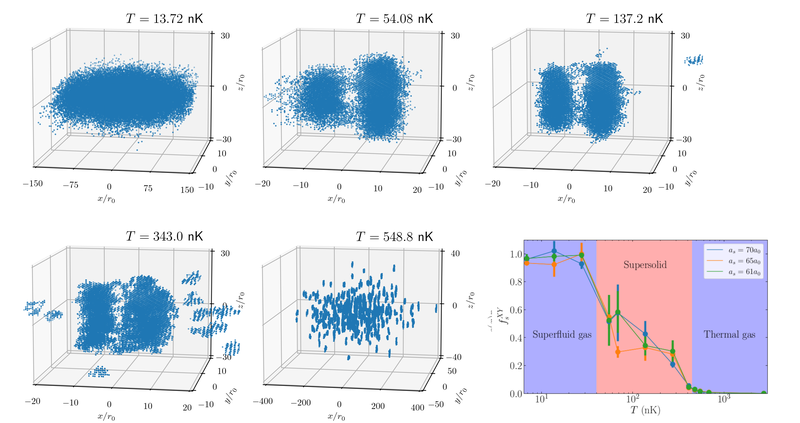Creation and destruction of a quantum dipolar supersolid by heating
Oct 27, 2025
A study by researchers Juan Sánchez-Baena, Ferran Mazzanti and Jordi Boronat, from the Polytechnic University of Catalonia, together with researcher Raúl Bombı́n, from the University of Bordeaux, shows for the first time the creation and destruction of a quantum supersolid by heating a dipolar system, initially in a superfluid phase without spatial order. The work illustrates the connection between the counterintuitive appearance of a solid by heating, exclusive to the quantum realm, and the expected phenomenology of fusion when the temperature is raised
A superfluid is a liquid or gaseous state in which particles can flow without friction. To visualize it, we can imagine that we rotate a bucket full of helium at a temperature below 4 Kelvin. If the rotation speed is low enough, the helium will remain at rest, even though the surface of the container it is in contact with is moving. A supersolid is an exotic state of matter that goes one step further: it mixes this strange property of superfluidity with spatial periodicity, reminiscent of a classical crystalline solid. In these supersolids, the atoms accumulate mostly at certain positions in space, while a halo of remaining atoms surrounds these majority concentrations.
Our everyday experience shows us that increasing temperature tends to destroy spatial order: if we heat a block of ice, where the atoms are ordered, it melts, and this order is lost when it passes into the liquid phase. If we continue heating, this liquid becomes a gas, where the particles occupy all the available volume. Quantum mechanics, however, is capable of turning this well-known phenomenology on its head: heating a dipolar system that is initially in a disordered superfluid state induces a transition to a supersolid state with spatial order that, in addition, preserves the property of superfluidity. If the system continues to heat up, the supersolid melts and superfluidity is lost, which is the expected phenomenology. All this happens at extremely low temperatures, of the order of nano-Kelvin. The work of the UPC researchers is the first instance where the connection and transition between these antagonistic behaviors has been explored. This has been possible thanks to the powerful computational Monte Carlo methods for studying quantum systems, the specialty of the UPC Barcelona Quantum Monte Carlo research group. Specifically, the Path Integral Monte Carlo method has been used, capable of solving, exactly, the quantum problem of N bodies at finite temperature.
The study represents a further step in understanding the relatively unexplored territory of finite-temperature dipolar systems. The conclusions also leave the door open to further unknowns to be investigated, such as the characterization of the dipolar system in the thermodynamic limit, or the relationship between the emergence of the supersolid upon heating and the formation of ultra-dilute dipolar liquid droplets.

Share: